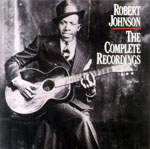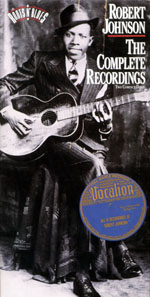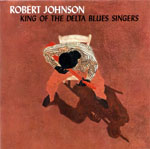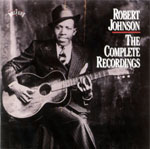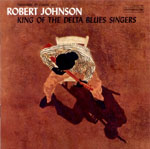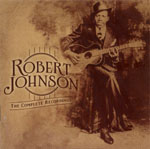Notes on the Robert Johnson recordings on CD
This document tries to make some sense out of what takes of Robert Johnson’s recordings have been released where. Please note this information is all gathered from the CDs themselves and any corresponding liner notes; I do not have access to any 78s (original releases nor test pressings), nor any Vocalion/ARC record cards (excepting Cross Road Blues, which is reproduced in the 2011 set’s booklet). The basis of this document is the notes at the rear of the booklet that came with the 1990 set. Additional information comes from the liner notes to the subsequent releases and from the actual audio on the CDs. These are the CD releases used for this research, referenced by the last two digits of their release year:
90 – The Complete Recordings, C2K 46222
94 – King Of The Delta Blues Singers, CK 52944 (gold/MasterSound edition)
96 – The Complete Recordings, C2K 64916
98 – King Of The Delta Blues Singers, CK 65746
04 – King Of The Delta Blues Singers (Vol. 2), CK 92579
11 – The Centennial Collection/The Complete Recordings, 88697 85907 2
17 – American Epic, 88875099692
Notes on the times – the times from the ’90 set come from the CD cases, and seem to be pretty accurate. For the other CDs, the time is from the beginning of the track to the end of the music, not counting additional time for fade out of surface noise. Note that the ’11 set in particular may have some extra time at the start of tracks due to fade-in of surface noise, and that the ’90 set does fade out some tracks quickly/early. The times listed on the back of the 1996 set are lifted directly from the 1990 set and are often incorrect.
Notes on take numbers – the 1990 and 1996 sets list take numbers with the lyrics where multiple takes were included. In the cases where only one take was included, take numbers were not listed; there is also no indication of take numbers in relation to the CD tracks, although in all cases (except Milkcow’s Calf Blues on the 1990 set), the CD tracks are in take order (take 1 followed by take 2). The 1998 CD does not list take numbers. The 1994, 2004 and 2011 CDs do list take numbers. Where discrepancies exist in numbering from one release to another, I have assumed the 2011 release to be correct. A few such discrepancies exist with the 1994 and 2004 CDs. The take and release information in the 1994 CD is reproduced verbatim from the original 1961 LP.
In some cases the notes to the ’90 set indicate a 78 r.p.m.
release while the notes to the ’11 set do not. I have noted those with a strikethrough.
Master takes, as indicated in the ’11 set, are noted in bold. Previous
issues did not differentiate between master and alternate takes.
Audio samples (40 seconds, FLAC) are linked from the track number/time entry for each track.
Please inform me of any additions or corrections. lukpac (at) gmail (dot) com.
Note from the ’90 set:
* These takes remain unfound, if ever issued; destroyed after being recorded (if ever); or otherwise unknown to collectors. In any event, they do not appear in this or any other album or collection.
Monday, November 23, 1936, San Antonio, Texas
Kind Hearted Woman Blues
SA 2580-1 Vocalion 03416, ARC 7-03-56
90 – 1.01, 2:49
94 – 1.07, 2:49
96 – 1.01, 2:49
98 – 1.07, 2:51
11 – 1.01, 2:52 (grace note at start not present on other CDs)
SA 2580-2 Vocalion 03416, ARC 7-03-56
90 – 1.02, 2:31
96 – 1.02, 2:28
04 – 1.01, 2:30
11 – 1.17, 2:30
I Believe I’ll Dust My Broom
SA 2581-1 Vo 03475, ARC 7-04-81, Conqueror 8871
90 – 1.03, 2:56 (grace note at start missing)
96 – 1.03, 2:57
04 – 1.02, 2:59
11 – 1.02, 2:58
SA 2581-2 not known to have been issued*
Sweet Home Chicago
SA 2582-1 Vo 03601
90 – 1.04, 2:59
96 – 1.04, 2:56
04 – 1.03, 2:58
11 – 1.03, 2:57
SA 2582-2 reportedly issued on Vo 03601, but unconfirmed*
Ramblin’ On My Mind
SA 2583-1 Vo 03519,
ARC 7-05-81
90 – 1.05, 2:51
94 – 1.11, 2:49 (labeled as -2, apparently incorrectly; correctly does not indicate release on Vocalion)
96 – 1.05, 2:50
98 – 1.11, 2:51
04 – 1.04, 2:51 (indicates release on Vo 03519, apparently incorrectly)
11 – 1.18, 2:50
SA 2583-2 Vo 03519, ARC 7-05-81
90 – 1.06, 2:20
96 – 1.06, 2:20 (significantly distorted compared to other transfers)
04 – 1.17, 2:22
11 – 1.04, 2:21
When You Got A Good Friend
SA 2584-1 previously unissued on 78 r.p.m.
90 – 1.07, 2:37
94 – 1.10, 2:36
96 – 1.07, 2:36
98 – 1.10, 2:38
11 – 1.05, 2:37
SA 2584-2 previously unissued on 78 r.p.m.
90 – 1.08, 2:50
96 – 1.08, 2:50
11 – 1.19, 2:52 (periodic surface noise not present on other CDs)
Come On In My Kitchen
SA 2585-1 previously unissued on 78 r.p.m.
90 – 1.09, 2:47 (grace note at start missing)
94 – 1.03, 2:50 (indicates release on Vo 03563, apparently incorrectly)
96 – 1.09, 2:49
98 – 1.03, 2:51
11 – 1.20, 2:50
SA 2585-2 Vo 03563, ARC 7-07-57
90 – 1.10, 2:35 (false start missing)
96 – 1.10, 2:42
11 – 1.06, 2:43
Terraplane Blues
SA 2586-1 Vo 03416, ARC 7-03-56
90 – 1.11, 3:00 (clip to illustrate lack of distortion present on 1998 CD)
94 – 1.02, 2:59 (clip to illustrate lack of distortion present on 1998 CD)
96 – 1.11, 2:58 (clip to illustrate lack of distortion present on 1998 CD)
98 – 1.02, 2:59 (significant distortion at 1:32, 1:41, 1:47, 1:56, 2:30)
11 – 1.07, 2:59 (clip to illustrate lack of distortion present on 1998 CD)
SA 2586-2 not known to have been issued*
Phonograph Blues
SA 2587-1 previously unissued on 78 r.p.m.
90 – 1.12, 2:37
96 – 1.12, 2:37
04 – 1.05, 2:39
11 – 1.08, 2:38 (mild periodic surface noise at start not present on other CDs)
SA 2587-2 previously unissued on 78 r.p.m.
90 – 1.13, 2:32
96 – 1.13, 2:31
11 – 1.21, 2:33
Thursday, November 26, 1936, San Antonio, Texas
32-20 Blues
SA 2616-1 possibly issued on Vo 03445, ARC 7-04-60, but unconfirmed*
SA 2616-2 Vo 03445, ARC 7-04-60
90 – 1.14, 2:51
94 – 1.06, 2:50 (labeled as -1, apparently incorrectly)
96 – 1.14, 2:47 (first note edited from different source; second beat of song edited out)
98 – 1.06, 2:50 (seems to have noticeable NR)
11 – 1.09, 2:49
Friday, November 27, 1936, San Antonio, Texas
They’re Red Hot
SA 2627-1 Vo 03563, ARC 7-07-57
90 – 1.15, 2:56
96 – 1.15, 2:56
04 – 1.06, 2:58
11 – 1.10, 2:57
SA 2627-2 not known to have been issued*
Dead Shrimp Blues
SA 2628-1 not known to have been issued*
SA 2628-2 Vo 03475, ARC 7-04-81, Cq 8871
90 – 1.16, 2:30
96 – 1.16, 2:29
04 – 1.07, 2:31
11 – 1.11, 2:30
Cross Road Blues
SA 2629-1 Vo 03519, ARC 7-05-81
90 – 1.17, 2:39
96 – 1.17, 2:37
11 – 1.12, 2:39
SA 2629-2 previously unissued on 78 r.p.m.
90 – 1.18, 2:29
94 – 1.01, 2:29
96 – 1.18, 2:27
98 – 1.01, 2:29
11 – 1.22, 2:27 (periodic surface noise until about 0:50 not present on other transfers)
17 – 5.01, 2:28
Walkin’ Blues
SA 2630-1 Vo 03601
90 – 1.19, 2:28
94 – 1.04, 2:28
96 – 1.19, 2:28
98 – 1.04, 2:29
11 – 1.13, 2:29
SA 2630-2 not known to have been issued*
Last Fair Deal Gone Down
SA 2631-1 Vo 03445, ARC 7-04-60
90 – 1.20, 2:39
94 – 1.05, 2:38
96 – 1.20, 2:37
98 – 1.05, 2:38
11 – 1.14, 2:37
SA 2631-2 reportedly issued on Vo 03445, ARC 7-04-60, but unconfirmed*
Preachin’ Blues (Up Jumped The Devil)
SA 2632-1 Vo 04630
90 – 2.01, 2:50 (grace note at start missing)
94 – 1.09, 2:50 (does not indicate release on Vocalion, incorrectly; grace note at start missing)
96 – 2.01, 2:49
98 – 1.09, 2:51
04 – 1.08, 2:51
11 – 1.15, 2:50
SA 2632-2 previously unissued on 78 r.p.m.*
If I Had Possession Over Judgment Day
SA 2633-1 previously unissued on 78 r.p.m.
90 – 2.02, 2:34
94 – 1.08, 2:33
96 – 2.02, 2:33
98 – 1.08, 2:34
11 – 1.16, 2:34
SA 2633-2 unissued*
Saturday, June 19, 1937, Dallas, Texas
Stones In My Passway
DAL 377-1 not known to have been issued*
DAL 377-2 Vo 03723, ARC 7-12-67, Cq 8973
90 – 2.03, 2:27
94 – 1.12, 2:26
96 – 2.03, 2:26
98 – 1.12, 2:29
11 – 2.01, 2:28
DAL 377-3 aurally identical to take 2 (electronically re-made 11/27/37)
I’m A Steady Rollin’ Man
DAL 378-1 Vo 03723, ARC 7-12-67, Cq 8973
90 – 2.04, 2:35
96 – 2.04, 2:34
04 – 1.09, 2:36
11 – 2.02, 2:35
DAL 378-2 not known to have been issued*
DAL 378-3 aurally identical to take 1 (electronically re-made 11/27/37)
From Four Until Late
DAL 379-1 Vo 03623, ARC 7-09-56
90 – 2.05, 2:23
96 – 2.05, 2:22
04 – 1.10, 2:24
11 – 2.03, 2:23
DAL 379-2 not known to have been issued*
Sunday, June 20, 1937, Dallas, Texas
Hell Hound On My Trail
DAL 394-1 not known to have been issued*
DAL 394-2 Vo 03623, ARC 7-09-56
90 – 2.06, 2:35 (grace note at start missing)
94 – 1.16, 2:34 (grace note at start missing; does not indicate release on Vocalion, incorrectly)
96 – 2.06, 2:34
98 – 1.16, 2:36
11 – 2.04, 2:36 (much better fidelity than other transfers)
Little Queen Of Spades
DAL 395-1 Vo 04108
90 – 2.07, 2:11
96 – 2.07, 2:10 (periodic surface noise not present on other transfers)
11 – 2.05, 2:11
DAL 395-2 Vo 04108
90 – 2.08, 2:15
96 – 2.08, 2:16
04 – 1.11, 2:20 (indicates release on Vo 04108, apparently incorrectly)
11 – 2.14, 2:19
Malted Milk
DAL 396-1 Vo 03665, ARC 7-10-65, Cq 8944
90 – 2.09, 2:17
96 – 2.09, 2:20
04 – 1.12, 2:21
11 – 2.06, 2:20
DAL 396-2 not known to have been issued*
Drunken Hearted Man
DAL 397-1 previously unissued on 78 r.p.m.
90 – 2.10, 2:24
96 – 2.10, 2:26
11 – 2.07, 2:29
DAL 397-2 previously unissued on 78 r.p.m.
90 – 2.11, 2:19 (grace note at start missing)
96 – 2.11, 2:25
04 – 1.13, 2:27 (labeled as -1, apparently incorrectly)
11 – 2.15, 2:26
Me And The Devil Blues
DAL 398-1 Vo 04108
90 – 2.12, 2:37
96 – 2.12, 2:32 (periodic surface noise not present on other transfers)
11 – 2.08, 2:34
DAL 398-2 Vo 04108
90 – 2.13, 2:29
94 – 1.15, 2:31
96 – 2.13, 2:31
98 – 1.15, 2:33 (periodic surface noise not present on other transfers)
11 – 2.16, 2:32
Stop Breakin’ Down Blues
DAL 399-1 Vo 04002
90 – 2.14, 2:16
96 – 2.14, 2:15
04 – 1.14, 2:16 (labeled as -2, apparently incorrectly; indicates release on Vo 04002, apparently incorrectly; periodic surface noise not present on other transfers)
11 – 2.17, 2:16
DAL 399-2 Vo 04002
90 – 2.15, 2:21
96 – 2.15, 2:21
11 – 2.09, 2:22
Traveling Riverside Blues
DAL 400-1 previously unissued
on 78 r.p.m.* (1996 set does not have asterisk, indicating take 1 was
located by that time, but it was not included)
98 – 1.17, 2:38
11 – 2.10, 2:39
DAL 400-2 previously unissued on 78 r.p.m.
90 – 2.16, 2:47 (intro guitar warm-up, no car horn before start)
94 – 1.13, 2:43 (no intro or car horn; abruptly cuts off at end)
96 – 2.16, 2:43 (no intro or car horn)
98 – 1.13, 2:56 (no intro, car horn present)
11 – 2.18, 2:52 (intro guitar warm-up, one note more than on ’90 set, car horn present)
Honeymoon Blues
DAL 401-1 Vo 04002
90 – 2.17, 2:16
96 – 2.17, 2:16
04 – 1.15, 2:16
11 – 2.11, 2:16
DAL 401-2 not known to have been recorded*
Love In Vain Blues
DAL 402-1 previously unissued on 78 r.p.m.
90 – 2.18, 2:28 (spoken intro, few beats of fast playing followed by triplets)
96 – 2.18, 2:23 (spoken intro, grace note into opening triplets missing)
04 – 1.16, 2:21 (no intro, opens with triplets; labeled as -4, apparently incorrectly; indicates release on Vo 04630, apparently incorrectly)
11 – 2.19, 2:25 (spoken intro, opens with triplets)
DAL 402-2 not known to
have been issued (see take 4)* (same performance as -4; 1996 and 2011 sets
note release on Vo 04630)
96 – 2.19, 2:15
11 – 2.12, 2:17 (grates notes at start not present on other transfers)
DAL 402-3 not known to have been issued (possibly electronically re-made from take 1 on 2/2/39, see take 4)*
DAL 402-4 Vo 04630 (electronically
re-made 2/2/39 from take 2 or 3)
90 – 2.19, 2:19 (same performance as -2)
Milkcow’s Calf Blues
DAL 403-1 not known to have been issued* (see take 3)
DAL 403-2 Vo 03665, ARC 7-10-65, Cq 8944
90 – 2.21, 2:20
96 – 2.21, 2:20
11 – 2.13, 2:20
DAL 403-3 Vo 03665, ARC 7-10-65, Cq
8944 (possibly electronically remade from take 1)
90 – 2.20, 2:14
94 – 1.14, 2:15
96 – 2.20, 2:15 (labeled as take 1; acknowledgement that take 3 was remade from take 1? Or typo?)
98 – 1.14, 2:16
11 – 2.20, 2:16
The take history of this song is somewhat muddy. First, a clarification of the two takes (differences noted in bold):
Take 2:
Tell me, milk cow
what on Earth is wrong with you?
Te-hell me, milk cow
what on Earth is wrong with you?
Well, well, you have a new calf, hoo hoo
and your milk is turnin’ blue
Take 3:
Te-hell me, milk cow
what on Earth is wrong with you?
Ooo ooo eee, milk cow
what on Earth is wrong with you?
Now, you have a little calf, hoo hoo
and your milk is turning’ blue
The above corresponds to the lyrics and take numbers given in the booklet that accompanies the 1990 set. It also corresponds with the take numbers given in the MasterSound King Of The Delta Blues Singers CD (taken from the original LP) and The Centennial Collection CD set. However, the order of the actual recordings on the 1990 set is reversed: take 3 is track 20 and take 2 is track 21.
On the 1996 version of The Complete Recordings, the order of the lyrics in the booklet has been changed to match the order of the recordings on the CD. Take 3 is first, followed by take 2. In somewhat of a twist, take 3 is labeled “take 1”; it is unclear if this is a typo (because it preceded take 2) or if “take 1” was used because take 3 was apparently re-made from take 1. The 1996 booklet omits the “possibly” that precedes “electronically remade from take 1”; however, both sets contain an asterisk, indicating take 1 is/was unfound.
Both the 1990 and 1996 sets indicate take 3 was also issued on 78, which contradicts the 1994 and 2011 CDs.
On The Complete Original Masters: The Centennial Edition (a limited edition set that contains 45 RPM reproductions of the 78s; not yet noted above), the booklet indicates take 2 was utilized. However, the actual recording is that of take 3 as indicated above.
The Centennial Collection does not indicate
that take 3 was issued on 78, but collector Lars Svendsen has a copy of Malted
Milk/Milkcow’s Calf Blues on Perfect that has take 3 (label scans, along with
information about the “dime store” releases can be found here). The
numbers stamped in the dead wax indicate it is take 2, stamper 3. However, as
with The Complete Original Masters, the actual recording is what is
called take 3 above. I have not yet been able to get in touch with somebody
with a copy on Vocalion to verify which performance was released and what take
number is indicated in the dead wax. If you have any knowledge in this regard,
please contact me.
It was previously believed that (as above) copies marked 2-3 (take 2, stamper 3) contained the audio for take 3. However, after listening again, Lars Svendsen, owner of the copy on Perfect, confirmed that the audio was in fact take 2. So there is no discrepancy.
The releases:
|
|
C2K 46222 © 1990 CBS Records Inc.
All recordings originally produced by DON LAW Roots ‘n’ Blues Series Producer: Lawrence Cohn Digital Restoration and Engineering: Frank Abbey Reissue Producers: Stephen LaVere and Frank Driggs Lps mastered by: Vlado Meller Project Coordination: Gary Pacheco, Mike Berniker, Amy Herot, and Steve Berkowitz Package Coordination: Tony Tiller and Rosemary Mulligan Design: John Berg Special thanks to Johnathan Horn, Joe McEwen, Peter Guralnick, Andy Franklin, Gregg Geller, and Gayle Dean Wardlow
Studio portrait of Robert Johnson – 1935 (Cover) © Stephen C. LaVere, 1989 Dime-store photo of Robert Johnson – early 1930s (p. 4) © Stephen C. LaVere, 1986
For more about the life and world of Robert Johnson, see Peter Guralnick’s recent book, Searching for Robert Johnson (E.P. Dutton)
PRODUCER’S NOTE: Every effort has been made to preserve the integrity of the original pre-stereo, analog recordings. The listener should be aware, however, that these transfers from metal or shellac parts contain imperfections which were inherent in the recording equipment and techniques of that time.
Original Mono Recordings
|
|
King Of The Delta Blues Singers (gold/MasterSound edition) CK 52944
Produced and edited by Frank Driggs
Recordings were taken from available metal masters at Columbia’s Bridgeport factory and from the following collectors: John Hammond, Bernard Klatzko, Henry B. Backey, Robert Stendahl and Peter Whelan.
The following have given much of their time and consideration in the preparation of this album: Helene Chmura, John Hammond, John Kelly and Don Law.
Remastering: Stanley Weiss
Cover Painting: Burt Goldblatt
MasterSound Edition: Reissue Producer: Lawrence Cohn Mastered by Kevin Boutote, Sony Music Studios, New York
Producer’s Note: This CD has been mastered from newly discovered, mint condition test pressings. These test pressings were struck from the original metal parts.
Each MasterSound disc is guaranteed to have been manufactured from the first generation mastertapes, actual session work tapes, or other original recording sources available. Where possible, original producers, mastering engineers, or the artists themselves have assisted in the production to insure the finest possible sound.
|
|
|
C2K 64916 © 1990 Sony Music Entertainment Inc.
All Recordings Originally Produced by DON LAW Roots N’ Blues Series Producer: Lawrence Cohn Roots N’ Blues Series Director: Adam Block Digital Restoration, Engineering and Remastering by David Mitson, Sony Music Studios, Los Angeles, CA (1996) Reissue Producers: Stephen LaVere and Frank Driggs LPs Mastered by: Vlado Meller Project Coordination: Gary Pacheco, Mike Berniker, Amy Herot and Steve Berkowitz Package Coordination: Tony Tiller and Rosemary Mulligan Design: John Berg Special thanks to Johnathan Horn, Joe McEwen, Peter Guralnick, Andy Franklin, Gregg Geller, and Gayle Dean Wardlow
Studio portrait of Robert Johnson – 1935 (Cover) © 1989 Delta Haze Corporation Photo booth self-portrait – early 1930s (p. 2) © 1986 Delta Haze Corporation
For more about the life and world of Robert Johnson, see Peter Guralnick’s recent book, Searching for Robert Johnson (E.P. Dutton)
PRODUCER’S NOTE: Every effort has been made to preserve the integrity of the original pre-stereo, analog recordings. The listener should be aware, however, that these transfers from metal or shellac parts contain imperfections which were inherent in the recording equipment and techniques of that time.
Original mono recordings remastered using SBM Super Bit Mapping
Additional notes:
When producer Lawrence Cohn and engineer David Mitson discovered long-lost tapes of bluesman Robert Johnson, it was as if they had found the tomb of King Tut.
Cohn and Mitson, the studio team responsible for much of Sony label Legacy's Roots 'N Blues series, point out that the Johnson tapes were stumbled upon, literally and figuratively, at Sony's Iron Mountain archive in New York state.
As Cohn tells it, two Sony producers leaned against something that turned out to be a hidden door. "Here was this sanctuary that no one at the facility knew about that had literally thousands of master tapes," he recalls with obvious glee. "The first box they tripped over were the Robert Johnson flat transfers."
Consequently, the Robert Johnson boxed set, originally released by Sony Legacy in 1990, recently was remastered in its entirety from the flat transfer tapes that were produced by Frank Driggs in the '70s. For Mitson, who was not involved in the original boxed set, the discovery gave him an opportunity to realize a long-held dream.
"I'd always wanted to redo the Robert Johnson (set) because it was the beta test of the archival reissue renaissance," says the 40-year-old Mitson. "You could hear the sound of the slide on the strings and rattles and clatters and throat noises," he says, beaming. "It was like Robert Johnson popped out of the tape machine in front of us."
Even Cohn admits that the sound quality of the original boxed set, mastered from an equalized dub, left a lot to be desired.
"To have undertaken a search for collectors' test pressings and 78s would have taken a year or two," he explains. "My fear at that time was the company would lose interest and close down the project."
Cromer, Ben. "Robert Johnson Tapes Found; Set Remastered." Billboard 07 Dec. 1996: 39-40. Print.
|
|
|
King Of The Delta Blues Singers CK 65746 © 1998 Sony Music Entertainment Inc.
Produced and edited by Frank Driggs
Recordings were taken from available metal masters at Columbia’s Bridgeport factory and from the following collectors: John Hammond, Bernard Klatzko, Henry B. Backey, Robert Stendahl and Peter Whelan.
The following have given much of their time and consideration in the preparation of this album: Helene Chmura, John Hammond, John Kelly and Don Law.
Original Remastering: Stanley Weiss Original Cover Painting by Burt Goldblatt All Other Artwork Courtesy of Lawrence Cohn Original Recording Producer: Don Law, American Record Corporation Original Recording Engineer: Vincent Liebler Original Recording Supervision: Art Satherly 1961 Reissue Album Producer: Frank Driggs, Columbia Records Digital Transfer Producer: Stephen C. LaVere, The Estate of Robert Johnson Original source material provided by Stephen C. LaVere, Richard Nevins (track 14), and Alan Jabbour, Library of Congress Archive of Folk Song (track 17) Disc to Digital Transfers: Steven Lasker, Michael Donaldson (track 17) CEDAR restoration: Steven Lasker, Venice, CA Sonic Advice: John R.T. Davies Digital Masters by Robert Vosgien, CMS Digital, Pasadena, CA Roots ‘n’ Blues Series Producer: Lawrence Cohn Project Direction: Adam Block, John Jackson Legacy A&R: Steve Berkowitz A&R Coordinator: Patti Matheny Art Director: Carol Grobe Packaging Manager: Ari Kast This title contains previously released material
Thanks to: Jeff Jones, Tom Cording, Randy Haecker, Darren Salmieri Steve LaVere’s special thanks to: Steven Lasker for his tireless efforts in transferring these performances so the world-at-large can hear Robert Johnson the way we 78-collectors do. Alan Jabbour for being so forthcoming in regard to a previously unknown alternate take of “Traveling Riverside Blues.” Lawrence Cohn for being so instrumental in the Robert Johnson phenomenon we are all presently enjoying. John Hammond and Frank Driggs for reissuing Robert Johnson’s recordings in the 1960’s, and Art Satherly, Don Law, and Vinnie Liebler for recording Robert Johnson in the first place.
Producer’s Note: If you know the location and/or present owner of the original Burt Goldblatt painting used for the cover of this classic reissue, please contact Stephen C. LaVere, in care of The Estate of Robert Johnson, Greenwood, Mississippi.
|
|
|
King Of The Delta Blues Singers (Vol. 2) CK 92579 © 2004 Sony Music Entertainment Inc.
Original Recordings Produced by Don Law Compilation Produced for LP by Frank Driggs CD Reissue Produced by Jerry Rappaport at Sony Music Studios, New York Mastered by Joseph M. Palmaccio at Sony Music Studios, New York Legacy A&R: Steve Berkowitz A&R Coordination: Stacey Boyle
Cover Art: Daily Planet/Tom Wilson Typographical Design: Nick Fasciano Art Direction: Howard Fritzson Design: Lisa Wolf
Special thanks to: Adam Block, Stacey Boyle, Tom Cording, Randy Haecker, Jeff Jones, Mike Kull, James Orofino, Michelle Scott
|
|
|
The Centennial Collection/The Complete Recordings 88697 85907 2 © 2011 Sony Music Entertainment
All Original Recordings Produced By Don Law Original Recording Engineer: Vincent Liebler Original Recording Supervision: Art Satherly
Producer for 2011 CD: Stephen C. LaVere Engineer: Steven Lasker Mastering Engineer: Seth Winner Legacy A&R Supervision: Steve Berkowitz
24-bit disc to digital transfer and initial CEDAR CAMBRIDGE restoration*: Steven Lasker, Venice, CA *Except CD 2, Track 10: Transfer courtesy of the Library Of Congress – Michael Donaldson, engineer Additional digital restoration and final assembly of masters – Seth B. Winner Sound Studios, Inc., Merrick, N.Y. Original source material provided by Stephen C. LaVere, Richard Nevins, John Tefteller and Alan Jabbour, Library of Congress, Archive of Folk Song
Project Manager: Gretchen Brennison Marketing Managers: Zak Profera and Mandy Eidgah Art Direction: Jeff Schulz at Menagerie Co. & Gretchen Brennison Design: Jeff Schulz at Menagerie Co.
Thank You: Vic Anesini, Adam Block, John Boncimino, Brady Brock, Michael Brooks, Larry Cohn, Didier D. Deutsch, Frank Driggs, Michael Eaton, Adam Fells, Amy Finkle, Michael Frank, Greg Geller, Trudy Greene, Allan Hammons, Bob Hoch, Randy Hoffman, Jeremy Holiday, John Jackon, Patrick Jordan, Kathy Kane, Bob Kaus, Howard Lau, Joe McCuen, Bob Merlis, Beth Miller, Ben Minnifield & Tanya Scott from the Robert Johnson Blues Foundation, Paul Nelson, Andrew Pressner, Kim Rappaport, Jane Rose, Jeffrey Schulberg, Maria Triana, Scooter Weintraub, Donny Whitehead, Mark Wilder
Special thanks to: Claud and Steven Johnson; Kitchens Law Firm for the Robert Johnson Estate; and to Stephen C. LaVere for invaluable contributions.
Additional notes:
Finally, it must be noted that the recordings appearing in this collection are all new digital transfers by the master of the medium, Steven Lasker. He has spent the last many years advancing a transfer technique that provides the most accurate capture yet devised of musical information from a concentric groove. The business end of the tone arm which he as adapted for this purpose looks like the head of a Rockhopper Penguin! Combining that with a seemingly endless range in size of conical and truncated, elliptical styli and you have the trappings of a sonic engineer madman-genius.
Once Lasker adeptly retrieved the true voice of Robert Johnson from the finest available original and test pressings, another magician, in the person of Seth Winner, took over and removed all the sonic noise from Lasker’s transfers – clicks, pops, stripped grooves and other minor imperfections that were inherent to the original pressings – absent the tonality of the disc surface hiss in full knowledge that in removing it all, some of the upper range of the musical information would be affected. What remains is every bit of the clarity of Robert Johnson’s recordings made during those halcyon days in Texas in the late 1930s.
LaVere, Stephen C. (2011). A History of the Recorded Masters. In The Centennial Collection (p. 23) [CD liner notes]. New York: Columbia Records.
"Hi Marc. The hiss was reduced, and most of the clicks and crackle were removed, by a single pass of CEDAR CAMBRIDGE. Then the 24-bit tapes went to Seth Winner, who spent some 50 hours intensively removing what clicks and crackle remained with CEDAR retouch, along with considerable 120-cycle hum that came off of the original recording equipment in Dallas in 1937. Seth also miraculously fixed the engineer's 'duck and recover' at the end of Malted Milk. He is the only person ever to fix this problem, which is found on the original 78-rpm and all other issues.
"I have something like 100 different styli to select from, and a proper fit gives best sound. Then, too, I use a stylus with a sensitive cantilever which picks up lots of musical information—and lots of non-musical extraneous vibrations, which is why most transfer engineers settle for a stylus with a stiffer cantilever.
"I've also figured out how to tame the non-musical vibrations with a tonearm stabilizer, a device of my own invention. This allows the stylus to consistently track down the very center of a lateral groove, which is where the small fractals are found. It allows me to track at a far lighter tracking force.
"This is important, because with a heavier tracking force, separation is lessened. The equation is the greater the separation, the less mud in a transfer. (The theory behind all this was first, at least to my knowledge, explained in an article in the September 1939 issue of Fortune magazine, which, among other things, attempted to explain why there was so much greater separation and higher fidelity on vertical recordings as opposed to lateral ones.)
"Better mechanical playback technique results in higher fidelity sound, it's that simple. By the way, there was next to no equalization applied to these transfers other than turnover eq.
"Thanks for the opportunity to share my thoughts about a subject I'm passionate about: how to get the best sound out of a 78-rpm coarse groove."
Lasker, Steven. Interview by Marc Myers. “Robert Johnson: Complete Tracks.” JAZZ.FM91. JAZZ.FM91, 26 Apr. 2011. Web. 01 Aug. 2014.
How do I get my sound? At the
phono pre-amp-stage, roll-off is flat, turnover is set at 300 hertz (most
transfer engineers stay at 500 hertz). There was next-to-no EQ in the digital
stage at my hands, although after it left here, Seth [Winner] inserted a
slight EQ notch or two on the high end where the hiss was most bothersome.
Lasker, Steven. “Robert Johnson”. E-mail to Luke Pacholski. July 27, 2014.
In 1993 or so, MCA Records (as Vivendi-Universal Music was then known) and the Muddy Waters estate sent me to the Library of Congress in Washington D.C. to oversee transfers of Muddy's Complete 1942 Plantation Recordings from their original media, 16-inch lacquer discs. I brought my guitar which I tuned, and then adjusted the speed of the turntable so that the pitch of Muddy's guitar recorded on the first disc being transferred matched that of my own. When I was satisfied I had the proper speed, we transferred the disc, and when it came almost to the end, we heard the recording engineer step up to the mike, strike a tuning fork, and exclaim "A440!" When we re-pitched the turntable to the default, 33 1/3 rpm, the tuning fork was heard in tune at A = 440. The lesson I learned that day: The old school, country bluesmen and women didn't necessarily tune their guitar when they recorded, especially when they weren't playing with a pianist.
So before Stephen LaVere arrived at my studio in late 2010 with his cargo of precious Robert Johnson 78s, I did a little research on some contemporary San Antonio recordings that featured a jazz band with was a piano I assume was tuned to A440. I have three of the four 78s Don Albert and his orchestra recorded for Vocalion on Wednesday, November 18, 1936, five days before Robert Johnson recorded for the label on what was surely the same equipment. The six sides I had by Don Albert were master numbers SA 2520-1, 2521-1, 2522-1, 2524-2, 2525-1 and 2526-1, and when the piano on these sides matched the pitch of my tuned guitar, I found my turntable had been adjusted to the following values, expressed as a percentage difference from the standard speed of 78.26: -0.4, +0.7, +0.9, +0.8, +1.1, +0.7. I excluded the high and low values, and took the average of the four that remained, which turned out to be +0.8%. So when LaVere arrived, I suggested we start listening at +0.8%, or 78.89 rpm. LaVere and I agreed that the voice and guitar both sounded natural at this speed, and as I recall we transferred most of the San Antonio recordings at this speed except for the two takes of Phonograph Blues which were transferred at a very slightly different speed.
When we transferred the Dallas recordings, we picked a different speed that sounded right to us both and consistent with the San Antonio recordings. The Dallas recordings had considerable 60/120 Hz hum which Seth [Winner] later notched out with EQ, but not before measuring the hum as accurately as he could. As I recall, he found the hum at between 120 and 121 Hz. As Seth says: "The hum doesn't lie!" The frequency of the hum was, of course, determined by the frequency of the AC, which in the U.S. and Canada was a constant 60 cycles.
Conclusion: The assertions made by some that all official reissues of Robert Johnson's recordings are grossly mis-pitched are grossly mistaken and frankly wacky!
Seth Winner adds:
I was able to visually view the hum in each selection via Cedar's plugin module in the Sadie Disc Editing system, while I was removing the remaining artifacts left that CEDAR's Cambridge Suite could not fully eliminate. In all cases, the hum due to the slight leakage in the power supply of the recording equipment used was just around 60 Hz, and at its first harmonic, 120 Hz. This undoubtedly proves that the transfers were played back at the correct speed for each side. I did run the files that Steven sent me through the CEDAR plug-in known as Decrackle, twice, which reduced some of the tracing distortion and small order crackle which was still present. A nominal amount of equalization was done to the recordings in order to remove the upper end noises associated with surface noise and EQ notches to attenuate 60 and 120 hertz hum.
A question was brought up concerning the sound of the unpublished sides sounding better than the issued ones. There is a simple reason for this: The published sides were pressed from stampers. This metal part is the third plating from the original lacquer masters cut at the session. The unpublished sides were pressed from the first metal part plated from the original lacquer master. Hence, the metal parts used for the issued sides were two plating generations away from the original metal part, and may have been slightly worn from stamper fatigue cause by use. The unissued takes were seldom if ever plated past the first electroplated part from the lacquer masters, and were used to make a limited amount of test pressings for audition purposes.
Lasker, Steven. “Speed issues....”. E-mail to Luke Pacholski. July 31, 2014.
|
|
|
88875099692 ℗ & © 2017 Sony Music Entertainment
ALBUM COMPILER AND EDITOR: Bernard MacMahon EXECUTIVE PRODUCERS: T Bone Burnett, Robert Redford and Jack White ALBUM PRODUCERS: Bernard MacMahon, Alison McGourty, Duke Erickson, Peter Henderson and Adam Block ASSOCIATE PRODUCERS: Jack McLean and Patrick Ferris ALBUM COMPILATION CONSULTANTS: John Tefteller, Michael Kieffer, Patrick Ferris, and Michael Brooks ALBUM LINER NOTES: Bernard MacMahon, Allison McGourty, Duke Erickson, Jack McLean, Patrick Ferris, Elijah Wald ART DIRECTION AND DESIGN: Nathanio Strimpopulos for Third Man Records ALBUM MASTERS: Joe Bussard, Lars Edegran and the George H. Buck, Jr. Jazz Foundation, Don Kent, Michael Kieffer, Chris King, Joe Lauro, Legacy Recordings and Sony Music Entertainment, Roger Misiewicz, Richard Nevins, Russell Shor, Chris Strachwitz, John Tefteller, and Pete Whelan 78 RPM RECORD TRANSFERS by Nicholas Bergh at Endpoint Audio Labs, Inc. AUDIO RESTORATION AND REMASTERING: Peter Henderson, Duke Erickson, Joel Tefteller and Nicholas Bergh MASTERED by Duke Erickson and John Polito at Audio Mechanics PHOTO AND IMAGE RESEARCH: Jack McLean and Patrick Ferris for Lo-Max Films Ltd. DISC PHOTOGRAPHS: Jack McLean, Dan Gitlin and Lilah Akin for Lo-Max Films Ltd. PHOTOGRAPHIC RESTORATION: Roger Robles, Bernard MacMahon and Dan Gitlin LEGAL: Ken Kraus, Loeb & Loeb, Chris Perez at Donaldson + Callif A&R FOR LEGACY: Rob Santos PRODUCT DIRECTION: Gretechen Brennison PROJECT MANAGEMENT: Greg Linn, Jim Parham and Jennifer Kirell
LEGACY THANKS: Richard Alcock, Erika Alfredson, Ben Blackwell, Tom Cording, Sam Erickson, Noah Gelb, Frank Harkins, Jeremy Holiday, John Jackson, Marisa Jeffries, Matt Kelly, Tom Mullen, Trevor Provost, Jeff Schulberg, Ben Swank, Tom Tierney, Mark Williams
Additional notes:
Our eureka moment came when we began working with sound engineer Nick Bergh, who after scavenging the world for original parts for over a decade had succeeded in rebuilding a 1920s-era Western Electric recording system. This gave him a unique understanding of this recording process and playback of the discs.
For this project, Nick refined a transfer process using a mix of both modern and vintage equipment in order to extract the remarkable resolution from the records that is often missed. This 'reverse engineering' approach to the transfer process enabled us to get the resulting audio closer to the original performance than ever before. In the case of this era of early recording, there can be truly amazing sound quality in the grooves, but to unlock it requires care and sophisticated transfer equipment based on the original electronics.
MacMahon, Bernard, et al. (2017). In American Epic (p. 10) [CD liner notes]. New York: Columbia Records.
|
